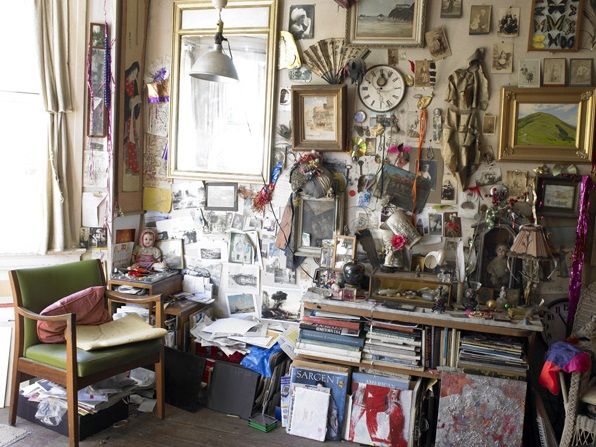Environment
Home Clutter, Confusion, and Chaos
Simplify, organize, and streamline your physical environment.
Posted July 8, 2012
Don't own so much clutter that you will be relieved to see your house catch fire.

Don't own so much clutter that you will be relieved to see your house catch fire.
Some time ago, I wrote a blog entry here about my tendency to accumulate books. I made the offhand comment that I am good at getting rid of stuff, except for books. I need to retract that statement, not insofar as it applies to books because I remain knee-deep in them but to other stuff. A few weeks ago, on the occasion of scheduling some home repairs, I decided to straighten up where I live so that it would be more presentable to strangers.
My straightening up shocked me because I discovered all sorts of stuff that I barely remembered having much less using: two dozen polo shirts still in their original packaging, five working telephones, two typewriters, an ironing board but no iron, and so on, and so forth. It was not as if any of this stuff had sentimental value. It had simply accumulated one item at a time over the more than two decades that I had lived in the same place. These things were tucked away in closets and cupboards and dresser drawers, although the excess of the excess also spilled out into my so-called living area. I had become so used to stepping over and around my stuff that I scarcely noticed it.
But when I paid attention, I became unhappy and realized that my home, although clean, was scarcely livable. I remembered the leave of absence I took in 2000 when I relocated to Philadelphia for a while, taking with me only what would fit in the trunk of my car. It was a productive and satisfying time for me. The work I was doing of course had a lot to do with that, but now I wonder if living in an uncluttered space and way also played a role. In Philadelphia, I could always find things. I was never late leaving my apartment. And I felt in control of my environment because I literally was.
Back to the present. Midst numerous trips to the dumpster and the Salvation Army, I happened across several research articles that confirmed my suspicions about the psychologically-damaging effects of clutter and confusion where one lives (e.g., Matheny, Wachs, Ludwig, & Phillips, 1995). This line of research studies the effects on children of living in what is termed a chaotic environment. On focus is not the interpersonal chaos that may preside in some homes; that too takes a toll. Rather, the focus is on physical settings that are noisy and disorganized. Children who live in these settings have more than their share of problems. Interestingly, one study about which I read ruled out a genetic influence on chaos and the problems it can cause (Jaffee, Hanscombe, Haworth, Davis, & Plomin, 2012). One might wonder if there is a common factor (based in genetic influences) responsible for both a chaotic home environment and troubled children, with no necessary link between them. That seems not to be the case. “Environment” has a main effect on problems.
My home is not all that noisy, and I of course am not a child, but I am willing to generalize the results because they provide practical suggestions about how all of us might live a better life. Simplify, organize, and streamline the physical environment where we live. Get rid of clutter. Minimize chaos. Reduce hubbub.
I have watched the A&E television show Hoarders often enough to know that people may strongly resist getting rid of their stuff, and I wondered if I would have the same reluctance. So I did some experimentation. After I bagged up things for the dumpster and boxed things up for the Salvation Army, I let them sit for a day or two. I monitored my reaction. I experienced no regret or remorse. Only satisfaction. So I took them out. I guess I inadvertently accumulate, but I do not obsessively hoard.
Positive psychology research tells us that materialism gets in the way of a satisfied life (Kasser, 2002). That is, the pursuit and accumulation of expensive things are barriers to living well. It also seems that the pursuit and accumulation of things per se — stuff — are also barriers.
References
Jaffee, S. R., Hanscombe, K. B., Haworth, C. M. A., Davis, O. S. P., & Plomin, R. (2012). Chaotic homes and children’s disruptive behavior: A longitudinal cross-lagged twin study. Psychological Science, 23, 643-650.
Kasser, T. (2002). The high price of materialism. Cambridge, MA: Bradford.
Matheny, A. P., Wachs, T. D., Ludwig, J. L., & Phillips, K. (1995). Bringing order out of chaos: Psychometric characteristics of the Confusion, Hubbub, and Order Scale. Journal of Applied Developmental Psychology, 16, 429-444.


